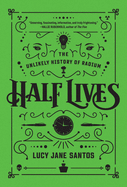
In Half Lives, science and popular culture combine in an engaging survey of the radium craze. Lucy Jane Santos makes her debut with an account of the uses and abuses of radioactivity, primarily in Britain, from its rising popularity as an alleged cure-all until it became an object of fear in the wake of the first nuclear bombs. Some of this history will be familiar to readers of The Radium Girls by Kate Moore; however Santos takes a broader, lighter approach. The realization that radium could have medicinal uses and the assumption that it was an unqualified positive brought more than just the frequently told story of the radium watch painters pointing their brushes with their lips. Spa towns such as Bath in Somerset, England, discovered and advertised the radium content in their waters. There was also a surge of sham patent cures implying they contained radium when they did not, alongside dance performances that incorporated radium-based products into the costumes or merely traded on the name.
Santos studies the effect of radioactivity on the popular imagination while striving not to impose hindsight on those who were inspired by its possibilities and ignorant of its dangers, reminding readers that if we and our contemporaries are more likely to be radiophobes, we still have to come to terms with the fact that radioactivity is everywhere. Fans of Mary Roach will find much to enjoy in this intriguing niche history. --Kristen Allen-Vogel, information services librarian at Dayton Metro Library

